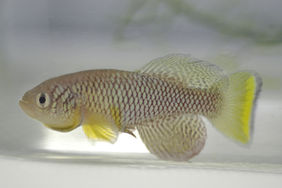N. furzeri – a new vertebrate model in age research
N. furzeri live in the Southeast of Africa, and have adapted to the natural habitat where water is only present during the short rainy season. Depending on locality, their life span varies between 3 (short-lived populations, rainy season ca. 3 months) and 10 months (longer-lived populations, rainy period at least 8 months). Also in optimal laboratory conditions, that is, unlimited availability of water and food, life span of the fish is similarly short as it would be in the wild. This strongly suggests that the information determining the extremely short life expectancy of N. furzeri is deposited and fixed in its genome (genome, all chromosomes containing all inheritable information).
Over recent years, the African turquoise killifish was established as a new vertebrate model organism at the Leibniz Institute for Age Research – Fritz Lipmann Institute (FLI) in Jena and since has been in the focus of several research projects. “Even though breeding the fish in the laboratory has been challenging, it is definitely worth the effort”, says Dr. Matthias Platzer who heads the Genome Analysis Group at the FLI. Starting in 2007, genome-wide sequence analyses were performed in his group resulting in the initial characterization of the N. furzeri genome. The size of it is 1.9 billion base pairs which is 2/3 the size of the human genome and bigger than that of other established fish model organisms (e.g., zebrafish and stickleback). “Because the human genome is closer related to the N. furzeri genome than to the genomes of roundworm or fly (which are two established short-lived models in aging research), we expect that we can translate findings from N. furzeri more faithfully to humans than is possible for worm or fly”, points out Dr. Platzer.
Researchers at the FLI have also tried to identify those regions in the N. furzeri genome where the information about the short life expectancy is encoded. In 2012 they have first identified four chromosomal regions which harbor determinants of the N. furzeri life span, based on classical crossing experiments of short- and longer-lived strains.
A genomic library of N. furzeri
In a joint effort between the FLI and the Clemson University Genomics and Computational Lab (GCL, Clemson, South Carolina, USA) the genome of the short-lived N. furzeri has now been made available to the scientific community in the form of a genomic library. “A genomic library is essentially an ordered catalogue of DNA fragments to systematically dissect the genome and underlying genes”, says Dr. Christopher Saski, Director of the GCL. DNA of N. furzeri was randomly fragmented into pieces of 150,000 base pairs on average that were inserted into bacterial artificial chromosomes (BACs). This allows for each DNA fragment of the fish genome to be maintained inside bacteria, be amplified and eventually analyzed in detail. The N. furzeri genomic library comprises 129.035 BACs, which together represent over 10 times the total size of the fish genome, and thus each region in the fish genome is represented by 10 different BACs on average. By sequencing the ends of the fish genomic inserts of 62.788 BAC clones the FLI group has determined exactly which part of the fish genome is carried by these clones. These DNA sequences have been deposited in DNA databases in Europe, USA and Japan and since January 2015 have been accessible to the scientific community. Both GCL and FLI maintain a copy of the genomic library and are open for clone requests. "If a certain gene or region of the N. furzeri genome needs to be studied in detail, we can easily provide the desired BAC clone(s) from our genomic library”, explains Dr. Kathrin Reichwald, project leader at FLI.
„The genomic library is an invaluable resource for researchers world-wide, because it allows performing genetic studies in N. furzeri without having to breed and maintain the fish, points out Dr. Reichwald. Currently, 45 research groups work on projects related to N. furzeri - mainly in Italy, Germany and the US. “By exploiting our genomic library as a common resource, the interest in this new and fascinating model will grow and likely nourish the field of aging research”, the researchers agree – especially since very recently a toolkit has been published by colleagues from Stanford University (USA) in the well-known scientific journal “CELL” in which it is described how N. furzeri genes can be effectively manipulated (www.ncbi.nlm.nih.gov/pubmed/25684364).
Publication
The Nothobranchius furzeri GRZ BAC library is accessible via GCL (SC, USA) at www.genome.clemson.edu/online_orders?page=serviceBrowse&service=bacrc. DNA sequences generated at FLI (Jena, Germany) have accession numbers KG817100 to KG925981 and are deposited at the „European Bioinformatics Institute“ (EBI/ENA: www.ebi.ac.uk/ena/data/view/KG817100), at the „DNA Databank of Japan“ (DDBJ: getentry.ddbj.nig.ac.jp/getentry/na/KG817100?filetype=html) and at „National Center for Biotechnology Information“ (NCBI: www.ncbi.nlm.nih.gov/nucgss/KG817100).
Contact
Dr. Kerstin Wagner
Leibniz Institute for Age Research – Fritz Lipmann Institute (FLI)
Beutenbergstr. 11, 07745 Jena
Phone: 03641-656378, e-mail: presse@fli-leibniz.de









